
The Nymphalidae are the largest family of butterflies, with more than 6,000 species distributed throughout most of the world. Belonging to the superfamily Papilionoidea, they are usually medium-sized to large butterflies. Most species have a reduced pair of forelegs and many hold their colourful wings flat when resting. They are also called brush-footed butterflies or four-footed butterflies, because they are known to stand on only four legs while the other two are curled up; in some species, these forelegs have a brush-like set of hairs, which gives this family its other common name. Many species are brightly coloured and include popular species such as the emperors, monarch butterfly, admirals, tortoiseshells, and fritillaries. However, the under wings are, in contrast, often dull and in some species look remarkably like dead leaves, or are much paler, producing a cryptic effect that helps the butterflies blend into their surroundings.

The grayling or rock grayling is a species in the brush-footed butterfly family Nymphalidae. Although found all over Europe, the grayling mostly inhabits coastal areas, with inland populations declining significantly in recent years. The grayling lives in dry and warm habitats with easy access to the sun, which helps them with body temperature regulation.
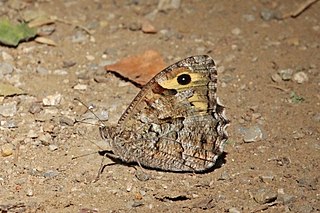
Hipparchia is a genus of butterflies within the family Nymphalidae. The genus was erected by Johan Christian Fabricius in 1807.

The Satyrini is one of the tribes of the subfamily Satyrinae. It includes about 2200 species and is therefore the largest tribe in the subfamily which comprises 2500 species.

Hipparchia parisatis, the white-edged rock brown, is a nymphalid species of satyrine butterfly found in Asia, including Turkey, Armenia, Iraq, Iran, Afghanistan, Turkestan, Uzbekistan, Tadzhikistan, the Palestinian Territories, India, the United Arab Emirates and Oman.
Hipparchia azorina, the Azores grayling, is a species of butterfly in the family Nymphalidae. It is endemic to the Azores. Its natural habitats are temperate forests and temperate grassland. It is threatened by habitat loss.

Hipparchia maderensis, the Madeiran grayling, is a species of butterfly in the family Nymphalidae. It is endemic to Madeira. Its natural habitat is temperate forests. Seitz treats it as a race of Hipparchia semele - in maderensis Baker, from Madeira the upperside in both sexes is strongly obscured and in the male almost without any markings.

Hipparchia fatua, or Freyer's grayling, is a butterfly of the family Nymphalidae. The species can be found from the Balkans, through Anatolia up to Iran.

Hipparchia hermione, the rock grayling, is a butterfly of the family Nymphalidae. The species can be found in Central Europe, Southern Europe, Eastern Europe, North Africa, Anatolia and the Caucasus.
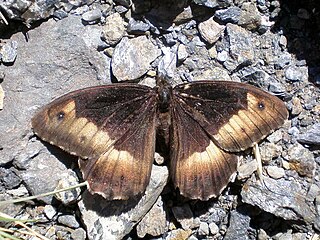
Hipparchia fagi, the woodland grayling, is a butterfly of the family Nymphalidae.

Hipparchia statilinus, the tree grayling, is a butterfly of the family Nymphalidae.
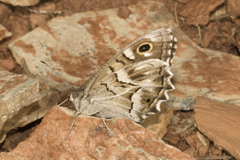
Hipparchia fidia, the striped grayling, is a butterfly of the family Nymphalidae. It is found on the Iberian Peninsula, the Balearic Islands and in south-eastern France and the bordering parts of Italy and North Africa.

Hipparchia hansii is a species of butterfly in the family Nymphalidae. It is endemic to the North African region, mainly Morocco, Algeria, Tunisia and western Libya. Its natural habitats are dense soil, grazed and rocky slopes, and ridges. It prefers to stay in the shade. This is one of the last butterflies that flies in the season.

Hipparchia syriaca is a species of butterfly in the family Nymphalidae. It is found in Greece especially on the island of Samos, Turkey, Bulgaria, Albania, North Macedonia, Caucasus and Transcaucasia. It is found on the edges of foothills and mountain forests up to 2,000 m

Hipparchia neomiris, the Corsican grayling, is a butterfly in the family Nymphalidae. It is an endemic species confined to the islands of Corsica, Sardinia and Elba. The Corsican grayling flies in July.
Hipparchia neapolitana, the Italian grayling, is a butterfly of the family Nymphalidae. It is an endemic species found only in the Campania region of Italy. neapolitana
Hipparchia sbordonii, the Ponza grayling, is a butterfly of the family Nymphalidae. It is an endemic species found only on the Pontine Islands of Italy.
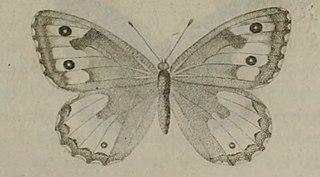
Hipparchia aristaeus, the southern grayling, is a butterfly of the family Nymphalidae. It was described by Franco Andrea Bonelli in 1826. It is found in North Africa, southern Europe and Asia Minor. The habitat consists of hot dry rocky areas.
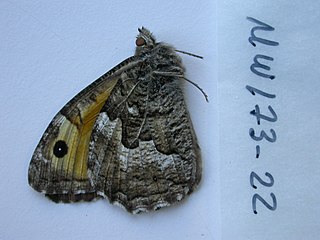
Hipparchia blachieri is a butterfly of the family Nymphalidae. It was described by Hans Fruhstorfer in 1908. It is endemic to Sicily and Malta.

Hipparchia genava, the lesser rock grayling, is a species of butterfly in the family Nymphalidae.
















